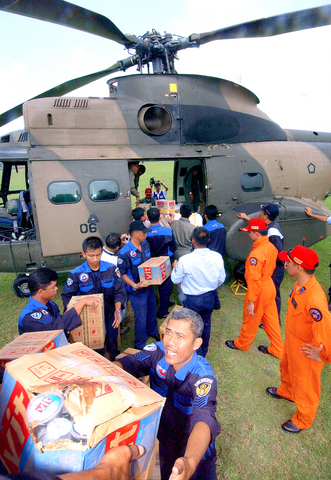What's the best design for a temporary toilet for Indonesian earthquake victims? How do you avert the outbreak of disease? How do you make sure children get back to school?
These are among the myriad of issues to be tackled by UN aid agencies and non-governmental organizations (NGOs) as they figure out how best to help the tens of thousands of people affected by the disaster.
"The first few days are about really pushing out as much assistance as possible, in as broad a way as possible, and not worrying too much about who is receiving it," top UN official Charlie Higgins told reporters.

PHOTO: AFP
"At the same time, you are doing assessment to find out where the real problem areas are, where the real priorities are," said Higgins, who is coordinating the work of UN agencies and other aid groups in the quake zone.
"And then you would try to direct the more blanket approach into a more targeted approach and meet the needs of people who are worst affected," he said.
Scores of aid workers from around the world have invaded a hotel in Yogyakarta, the main city in the quake zone, trying to piece together bits of information from the ground and ensure they do not waste scarce resources.
After a day of exhausting work in the field, small groups of seven to 15 people gather in the evening heat to thrash out strategies on everything from health to education, waste management to the treatment of drinking water.
The WatSan group -- agency-speak for water and sanitation -- gathers in a hotel hallway. Their biggest worry? Temporary latrines are needed to stave off disease and sewage problems.
"People have nowhere to go to the toilet, so if it's raining you've got what they're doing on the ground flowing around the place," explains UNICEF engineer Dara Johnston, who is the WatSan chair. "The children are walking around with bare feet and there are various dangers there."
So the group analyses the details of how best to build the latrines. An Oxfam representative unveils one design that requires plastic sheeting, wood planks and ceramic fittings. The committee members voice their approval of the plan.
"Oxfam has already researched emergency latrines. USAID also has designs so we can compare it, revise it, criticize it and hopefully we can get standard designs," said Avianto Amri of children's charity Plan International.
A UNICEF representative then reports a small increase in diarrhea cases in a remote mountainous village in Bantul, one of the worst hit areas.
Workers decide to rush water trucks and facilities to the village. They agree to report back the following day.
Later that evening, over 65 aid workers packed themselves into a hotel meeting room to share their reports with Higgins -- a solemn, efficient occasion, as those present try to synthesize what they have seen that day.
People note death and injury statistics with concern, share phone numbers and cheer efforts by other workers to set up communication lines and computers.
There is also a brief discussion about "early recovery" -- planning for the long-term rehabilitation of the quake zone even as immediate aid efforts are still long from over.
"In the past, many mistakes have been made when it comes to longer-term recovery because people have been too intent on meeting immediate needs without thinking of the longer term impact of what they've done," says Robin Willison, a technical advisor to the UN Development Programme (UNDP).
"For instance, in the earthquakes they had in Turkey, they built these big temporary towns, and then they had to come in and bulldoze entire towns and then rebuild permanent buildings. That swallowed up a large amount of money," he said.
Higgins admits it was not easy to bring all the agencies together, and acknowledges the challenges of making sure work is not duplicated, but says the effort is a worthwhile one.
"The main aim is to bring them in," he said. "But then once you get them in there, you have to meet their expectations and engage their interests and keep them happy."
So how does he balance all the different interests and ideas about how aid should be delivered?
"It's difficult," Higgins says.

A feud has broken out between the top leaders of the far-right Alternative for Germany (AfD) party on whether to maintain close ties with Russia. The AfD leader Alice Weidel this week slammed planned visits to Russia by some party lawmakers, while coleader Tino Chrupalla voiced a defense of Russian President Vladimir Putin. The unusual split comes at a time when mainstream politicians have accused the anti-immigration AfD of acting as stooges for the Kremlin and even spying for Russia. The row has also erupted in a year in which the AfD is flying high, often polling above the record 20 percent it

Philippine President Ferdinand Marcos Jr yesterday vowed that those behind bogus flood control projects would be arrested before Christmas, days after deadly back-to-back typhoons left swathes of the country underwater. Scores of construction firm owners, government officials and lawmakers — including Marcos’ cousin congressman — have been accused of pocketing funds for substandard or so-called “ghost” infrastructure projects. The Philippine Department of Finance has estimated the nation’s economy lost up to 118.5 billion pesos (US$2 billion) since 2023 due to corruption in flood control projects. Criminal cases against most of the people implicated are nearly complete, Marcos told reporters. “We don’t file cases for

Ecuadorans are today to vote on whether to allow the return of foreign military bases and the drafting of a new constitution that could give the country’s president more power. Voters are to decide on the presence of foreign military bases, which have been banned on Ecuadoran soil since 2008. A “yes” vote would likely bring the return of the US military to the Manta air base on the Pacific coast — once a hub for US anti-drug operations. Other questions concern ending public funding for political parties, reducing the number of lawmakers and creating an elected body that would

‘ATTACK ON CIVILIZATION’: The culture ministry released drawings of six missing statues representing the Roman goddess of Venus, the tallest of which was 40cm Investigators believe that the theft of several ancient statues dating back to the Roman era from Syria’s national museum was likely the work of an individual, not an organized gang, officials said on Wednesday. The National Museum of Damascus was closed after the heist was discovered early on Monday. The museum had reopened in January as the country recovers from a 14-year civil war and the fall of the 54-year al-Assad dynasty last year. On Wednesday, a security vehicle was parked outside the main gate of the museum in central Damascus while security guards stood nearby. People were not allowed in because